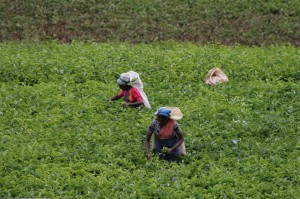Plantations – Where are we heading
The plantation sector as a whole is facing major problems such as an acute shortage of workers, declining tea price in real terms which are not keeping pace with the price increases of other beverages and food items and the ever increasing cost of production.
President Mahinda Rajapaksa when he was the Prime Minister speaking at the launch of the book “Twentieth Century Tea Research in Sri Lanka” in 2004, questioned, what would the tea industry be in the next 15 years? What would the solutions be at that time when a problem arises? Are we ready to face such a situation?
He noted that as the Prime Minister of the country, his concern lies with what the focus of the industry will be in another 15 or 20 years, its goals and possible challenges that the industry would encounter and what possible strategies the Tea Research Institute (TRI) and the relevant authorities could evolve to stand them in good stead. It was an encouraging and pleasing comment.
In the agriculture sphere, significant advances have been made in other countries – India for example. They apply techniques of rejuvenation. Most countries have developed mechanical harvesters for use in areas with labour shortages. India did not nationalize her plantations and managers of the plantations who are private sector personal are able to take care of and make use of new technologies in agriculture, manufacture and even in marketing to their great benefit.
Our plantations managed by the private and state sectors are performing at a tremendous loss in many instances. Since there is a direct relationship in yield and cost of production, low yields imply low competitiveness, even if prices show upward trend, the losses occur.
The plantation sector has stagnated in terms of productivity while the costs have increased and profits have eased.
The logical means of increasing productivity on plantations is replanting and infilling. We greatly appreciate the generosity of the National Development Bank (NDB) for coming forward to strengthen the plantation sector by approving and providing approximately Rs. 2.5 billion in loans needed for “Field Development and Factory Modernization”.
The slow pace of replanting now is very striking. From the point of view of individual managements, the reasons for the slow pace of replanting are economic – high investment and negative returns. But replanting has to be seen in a wider national perspective.
Tea is among the most labour intensive of all the plantation crops. It has both an agricultural and a manufacturing dimension.Although, these have been discussed over and over again, it is still considered beneficial to re-examine this subject of replanting. By enhancing field productivity, replanting also generates much higher employment-per unit area than the old seedling fields. To achieve the desired results, state intervention and assistance is necessary for the long term development of the industry.
The TRI has a vital role to play which involves selecting the suitable land, uprooting of old bushes, rehabilitation of soil or whether direct planting could be undertaken, planting of tea and maintenance of the young tea fields till maturity.
In addition, the TRI has to select the new varieties of high yielding plant material that could result in faster production.
The Ministry of Plantation has to appoint a Task Force comprising knowledgeable planters or individuals to monitor this project step by step from the beginning.
We all know that Minister of Plantations Mahinda Samarasinghe is doing his best at the moment and we take our hats off to him for his efforts but there are many unresolved issues and challenges affecting the tea industry. It is therefore important that the tea industry should endeavour within limits and approach to all relevant issues through enhanced productivity and other factors of management in order to regain its prestige.
Everybody in the tea industry talks about the productivity, cost of production and efficient land management. Productivity improvement alone cannot make our industry survive. The real problem I see is not the inefficiency or low productivity, but the low prices we get for our tea. While I do not wish to be controversial, the question needs to be asked whether the producer is getting the right price.
In conclusion there is a definite need for support from the Government, the TRI, all stakeholders, workers, trade unions etc. The Chairman, Planters Association, Lalith Obeysekere too should persuade the authorities concerned of the dire need to support the “ Field Development and Factory Modernization” project funded by the NDB considering the fact that unless replanting is carried out in a vigorous manner the industry will be uneconomical.
(The writer is a Plantations industry expert)
Follow @timesonlinelk
comments powered by Disqus


